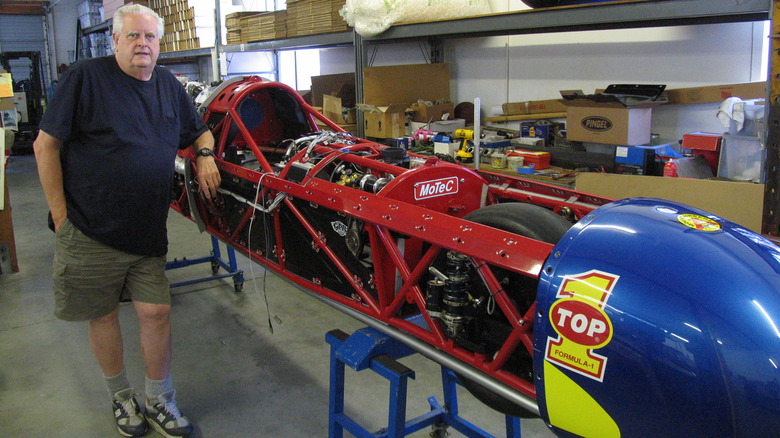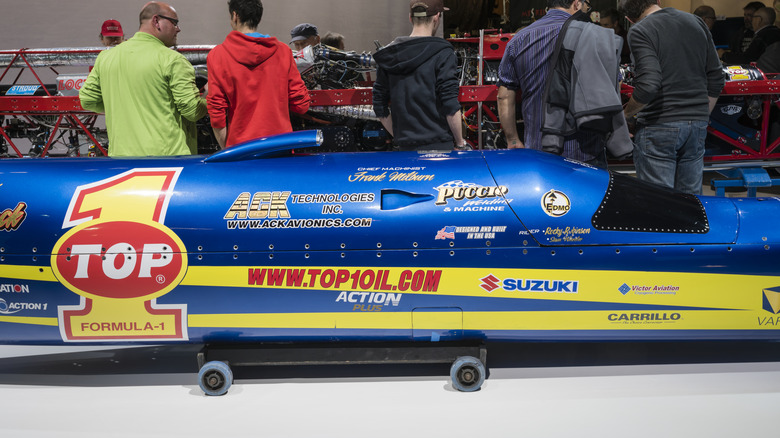How Fast Is The Motorcycle That Holds The Current Land Speed Record?
The race for the fastest land speed record on a motorcycle has been a hotly contested accolade ever since the first motorcycles hit the roads. The evolutionary history of motorcycle engines has always been closely tied to the maximum speed records. However, hobbyists, not manufacturers, are often the winners, as their tinkering and modifications push motorcycles to their absolute limits.
Yet, even with extreme motorcycle modification, the current land speed record has stood uncontested for over 15 years. According to Guinness World Records, the fastest land speed ever achieved by a motorcycle is 605.697 km/h, or 376.363 mph. The record was set on September 25th, 2010, ridden by Rocky Robinson in the Bonneville Salt Flats of Utah. And while that official record was a two-way average, observers at the event actually recorded the bike achieving an exit speed of 394 mph. Furthermore, Rocky Robinson states on his blog that the data loggers clocked the bike reaching over 400 mph during the run. The Ack Attack team's wind-tunnel tests also suggest the bike is capable of exceeding the 400-mph mark.
Achieving the record wasn't a history of easy successes. Ack Technologies put their designs through years of trials, with death-defying tests that often resulted in dramatic rolls and crashes. At least one death, that of Sam Wheeler in 2016, was associated with the Ack Attack team while testing a streamliner. Ultimately, the bike's record-breaking speed was recorded at the AMA Land Speed Grand Championships, held every year at the Bonneville Speedway in the United States. Also called the BUB Motorcycle Speed Trials, the racetrack's competition is the main event for securing records and glory by souped-up bikes.
The unique build of the Top 1 Ack Attack motorcycle
The Top 1 Ack Attack achieved the fastest recorded land speed for a motorcycle, and it barely looks like a motorcycle. In fact, it's so heavily modified that many of its specs are near those of the fastest supercars in the world. For starters, the Top 1 Ack Attack used not one but two engines to reach its top speed. Its two 1299cc Suzuki Hayabusa motors employ a Garrett turbocharger to apply a massive amount of torque to the rear wheel. Normally, such an absurd amount of power would lead to unmanageable temperatures, but the Top 1 Ack Attack's dual chains were water-cooled to maintain their performance.
At 376 mph, wind resistance is a huge factor. To address the effects of drag from the air, the Top 1 Ack Attack was designed to essentially mimic a bullet or a rocket. Its chassis was constructed of a material called "chromoly," a steel alloy that sacrifices rust resistance for a high strength-to-weight ratio. The result is a lightweight vehicle that bears little resemblance to a standard motorcycle yet still maintains the two-wheeled, single-seated design to classify as one.
Appearances can be deceiving. Although boasting a 12-foot wheelbase, an enclosed interior, and a 1,617-pound curb weight, the bike has surprisingly conventional controls. The Top 1 Ack Attack uses a right-side throttle with a nitrogen-assisted clutch on its left side. And to the credit of its rider, Rocky Robinson, gear shifting was via a standard foot shifter pedal. Its brakes aren't as conventional. It has a hand lever on the right handlebar and a left-sided foot brake. Thus, at its exceptional speeds, the bike depends on two parachutes from simple triggers on the right side.
Why the Top 1 Ack Attack's record hasn't been broken in 15 years
The fastest land speed record for a motorcycle has been hotly contested for over a century. The fact that the current record has been held for a decade and a half is unusual, since records were typically broken every few years across the 20th century. What gives the Top 1 Ack Attack's design such an undefeatable speed? It's easy to assume that engineering has reached its limits, but environmental factors may be at play.
In the 21st century, land speed records have been passed between mods of BMWs, Hondas, Harleys, Suzukis, Yamahas, Triumphs, and other big names, with each new speed record taking place at the Bonneville Speedway. In fact, the Bonneville Speedway has been the unofficial capital of speed records since 1912, where its unique salt flats produce a hard-as-concrete natural surface for racing. Indeed, the Bonneville Speedway has hosted other records as well, including the record for the fastest speed ever reached by a land vehicle.
Unfortunately, the integrity of the Bonneville Salt Flats has degraded in recent years, often resulting in conditions too dangerous for new speed trials. Most recently, the 2023 Bonneville Motorcycle Speed Trials Event was cancelled in 2023 due to Hurricane Hilary, and it was cancelled in 2015 for weather, as well. In years that the event wasn't cancelled, riders have increasingly experienced issues with soggy patches that ruined chances for new records. A combination of unpredictable weather and hydraulic mining activity in the area seems to be the culprit. In any case, it's clear that the Bonneville Salt Flats are shrinking in size and hardness, and the opportunity to break the motorcycle land speed record is shrinking along with it.


